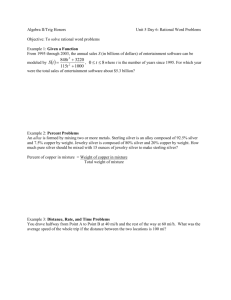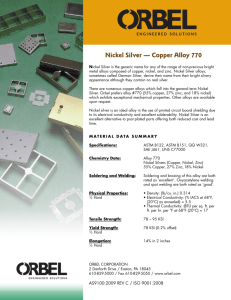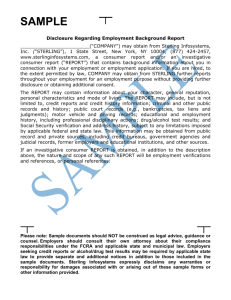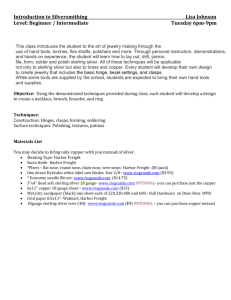MACHINES FOR A PERFECT WORLD By Christopher Robin Tullar
advertisement
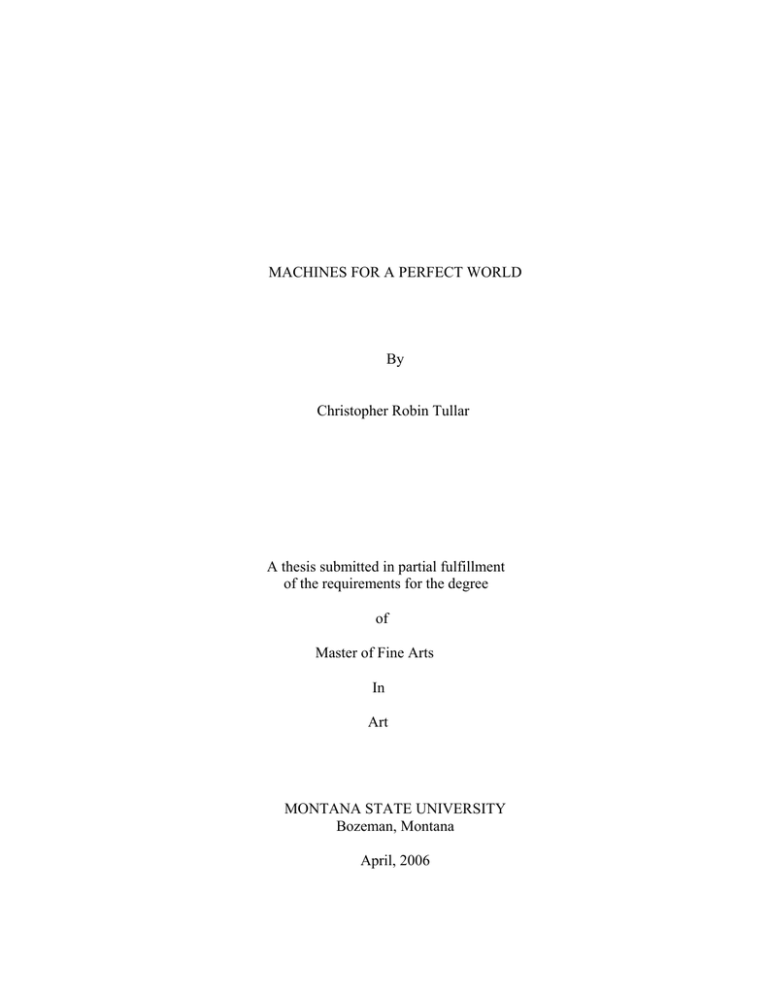
MACHINES FOR A PERFECT WORLD By Christopher Robin Tullar A thesis submitted in partial fulfillment of the requirements for the degree of Master of Fine Arts In Art MONTANA STATE UNIVERSITY Bozeman, Montana April, 2006 ©COPYRIGHT By Christopher R. Tullar 2006 All Rights Reserved ii APPROVAL of a thesis submitted by Christopher R. Tullar This thesis has been read by each member of the thesis committee and has been found to be satisfactory regarding content, English usage, format, citations, bibliographic style, and consistency, and is ready for submission to the College of Graduate Studies. Chairperson, Graduate Committee Richard Helzer April 10, 2006 Approved for the School of Art Head, Major Department Richard Helzer April 10, 2006 Approved for the College of Graduate Studies Graduate Dean Dr. Joseph Fedock April 10, 2006 iii STATEMENT OF PERMISSION TO USE In presenting this thesis in partial fulfillment the requirements for a master’s degree at Montana State University, I agree that the Library shall make it available to borrowers under rules of the Library. If I have indicated my intention to copyright this thesis by including a copyright notice page, copying is allowable only for scholarly purposes, consistent with “fair use” as prescribed in the U.S. Copyright Law. Requests for permission for extended quotation from or reproduction of this thesis in whole or in parts may be granted only by the copyright holder. Signature Christopher R. Tullar Date April 10, 2006 iv LIST OF IMAGES Images Page 1. Installation view and artist 4 2. Installation view 5 3. Machine #3, Nickel Silver, Sterling, Petersite, Rutilated Quartz, 2.5x1.5x1.5” 6 4. Machine #3, Detail 7 5. Machine #4, Nickel Silver, Sterling, Quartz, 2.75x2x1.5” 8 6. Machine #4, Detail 9 7. Machine #5, Nickel Silver, Sterling, Quartz, Copper, 10x4x2” 10 8. Machine #5, Detail 11 9. Machine #6, Nickel Silver, Sterling, Quartz, Fire Opal, Copper, 4x2.5x2.5” 12 10. Machine #6, Detail 13 11. Machine #7, Nickel Silver, Sterling, Agate, Copper, 6x4x2.75” 14 12. Machine #7, View 15 13. Machine #7, Detail 16 14. Machine #8, Nickel Silver, Sterling, Agate, Glass, Copper, 6.5x5x2” 17 15. Machine #8, Detail 18 16. Machine #8, View 19 17. Machine #9, Nickel Silver, Sterling, Fire Opal, Agate, Petrified Wood, Glass, Copper, 6.5x5x5” 20 18. Machine #9, Detail 21 19. Machine #9, Detail 22 20. Machine #10, Nickel Silver, Sterling, Agate, Glass, 6x5x5” 23 21. Machine #10, Detail 24 22. Machine #10, Detail 25 23. Machine #11, Nickel Silver, Sterling, Agate, Glass, 10x6.5x6” 26 24. Machine #11, View 27 25. Machine #11, Detail 28 23. Machine #11, Detail 26 1 Wonder, optimism, and discovery are to me the most positive and exciting aspects of exploration of any kind. These are the central themes in Machines for a Perfect World. My main goal in putting this show together is to create pieces that incite these emotions and ideals in the viewer. The visual languages I utilize to this end are those of science fiction, industry, and architecture – aesthetic influences of mine from as far back as I can recall. Science and more specifically, the fictional accounts surrounding the future of scientific discovery have a particular resonance that has always captivated my curiosity and stimulated my imagination. Paralleling and complimenting this interest is my fascination with machines and building, and the processes involved therein. I have my father to thank for these obsessions. He encouraged me from a young age to read science fiction and made a point of taking me to every new sci-fi movie that came out. He even managed to get tickets to the premier of The Empire Strikes Back, in 1980, when we were living in Los Angeles. He was also an avid builder of things. Consequently, my earliest defining moments have to do with observing my father while he did his projects and soaking up his love for science fiction. Predictably, when I was going through Art History Survey as an undergraduate, what began as an exercise in tolerance with memorizing the names of partially intact Greek sculptures, blossomed into genuine excitement when we finally got to Modern Art. I responded specifically to the work of the Constructivists, the Bauhaus, and other early 20th century, European groups. The writing of manifestos, development of utopian philosophies, and optimism about the merging 2 of machines and industry with aesthetic practice made perfect sense to me. The fact that these movements were generally more open to the inclusion of craft based artistic pursuit was also appealing to me as a metalsmith. The work in Machines for a Perfect World is a synthesis of these early influences and experiences and the intervening ten years of professional and academic happenings. Working as a goldsmith for five years, and experimenting with a more sculptural sensibility here at graduate school have yielded a group of pieces that defy any easy labeling. They owe their scale and methods of building to the world of functional metalsmithing, such as jewelry and silversmithing, but they deny any attachment to specific function. I say specific function because the pieces do allude to functionality, but one of my key goals is the suggestion of function without definition. With this, I hope to create small mysteries that require the viewer to do some imagining of their own. The shapes and forms I use come from observation of the world around me. Heavy machinery, cars, radio towers, scientific devices, and countless other objects that we encounter every day are the visual fodder for these pieces. The lenses and reflective surfaces evolved out of my propensity to contrast my mechanical structures with organic forms and materials. Long ago I settled on stones as the organic material that provided the opposing or balancing agent in that dialogue. At first I polished parts of the stones and left other parts in their natural state. I took my cues in shaping them from the way that I found them. This approach was successful from time to time, but often left me with an object that was visually overwhelming and difficult to work with. The lens shape is satisfying to me because it showcases the naturally beautiful inner structure of the stones, but also references science. 3 By accident, I discovered that some of the stones I cut had optical qualities. This sparked a whole new exploration of the ideas of functionality and aesthetics co-mingling. What began as small, almost wearable pieces that involved one or two stones have evolved into much larger, more complex constructions with numerous stones, manufactured lenses, and specially designed reflectors. Machines for a Perfect World visualizes a world where there is a co-mingling of aesthetics with industry, form with function. It is also speaks metaphorically to a world in which contradictory forces within and outside ourselves can be reconciled. It is a homage to all the different worlds that I inhabit. The world of reality, the world of fantasy, the world of science, and the world of nature are all worlds that we experience every day. These pieces encompass a little bit of each of these different spheres. My hope is that they encourage you to look freshly on your world, to find wonder in things you may have taken for granted, and most importantly, remain curious. 4 1. Installation view and artist 5 2. Installation view 6 3. Machine #3 7 4. Machine #3, Detail 8 5. Machine #4 9 6. Machine #4, Detail 10 7. Machine #5 11 8. Machine #5, Detail 12 9. Machine #6 13 10. Machine #6, Detail 14 11. Machine #7 15 12. Machine #7, View 16 13. Machine #7, Detail 17 14. Machine #8 18 15. Machine #8, Detail 19 16. Machine #8, View 20 17. Machine #9 21 18. Machine #9, Detail 22 19. Machine #9, Detail 23 20. Machine #10 24 21. Machine #10, Detail 25 22. Machine #10, Detail 26 23. Machine #11 27 24. Machine #11, Detail 28 25. Machine #11, Detail

